Story and Photos by Dick Ruzzin
Be sure to watch this extremely interesting interview with Dick Ruzzin on Sean McElroy’s Autoline After Hours. The segment with Dick begins at about the 49 minute mark, right after the commercial. If you don’t know Dick’s background as a GM designer, you will be impressed.
Vehicle Architecture
The mid-engine architecture is very exciting to design around as it provides unique proportions that can be interpreted in profile with almost a single curving line. The Mangusta design is enhanced greatly by the architecture, the short overhangs, wide front and rear tread, the low front suspension, and the large wheels and tires encourage the design of a shape that is very idealistic. The architecture delivers proportions that are very dramatic and the idea that there is an inherent special high performance functionality included in the vehicle concept only enhances the simple, sporty and elegant design solution that was conceived and executed by Giorgetto Giugiaro.
Design Theme Selection and Design Longevity
The reason that the design has lived so well for so long is the fact that Giugiaro’s basic design choice is an idealistic timeless simple theme that is beautifully executed with a great deal of sophistication and skill by the designer. The source of the design character comes from Giugiaro, and the mid-engine architecture under the skin that is a high performance purpose-built racing platform. A very important element in the Mangusta design concept is the fact that the car would be air conditioned and have electric side windows. This allowed Giugiaro to create a body side section with a window that would not go all the way down. The elimination of the window space in the lower door resulted in a dramatic side section that has a profound impact on the design solution from front to rear. This compromise is a key element in the design success of the Mangusta. Other required manufacturing variations from the basic surfaces as conceived were handled in very subtle ways so that they would not detract from the simplicity of the theme.
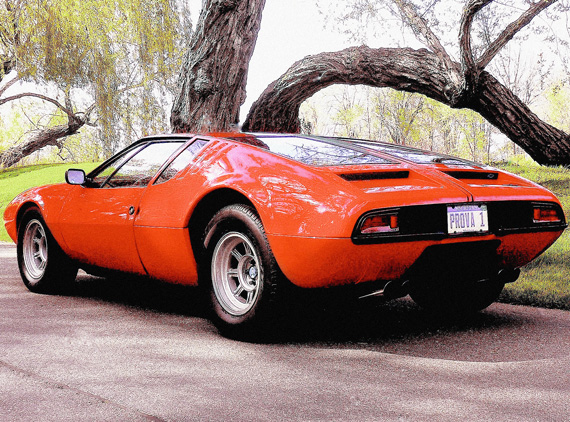
The rear of the Mangusta shows the large tires required for the extra weight and traction needed as well as air openings for release of heat.
The design followed no current trend; it is not stylistic, exaggerated, or overstated in any way as it carefully skins the racing chassis components, like a race car body. This opportunity to use a theme without exaggeration was presented to the designer because of the very flattering and dramatic proportions of the basic architecture. Still, Giugiaro was very brave and confident to use such a simple theme, one that included the exciting and subjective implication of speed and performance with a high dependency on artistic execution. His choice had to be reinforced by the success of one of his previous designs, done while at Bertone, the Alfa Romeo Canguro. A concept car, it also had a very elegant and simple theme that gained a great deal of attention in Turin when shown several years before the Mangusta. Completely round in its form language and with rear wheel drive, the Canguro is the literal opposite of the Mangusta in its basic theme, shape, and architecture.
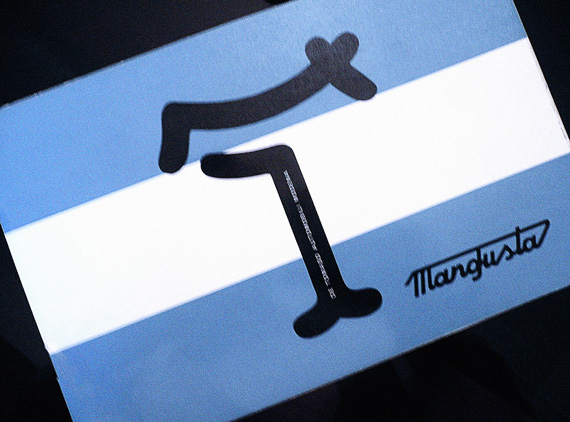
The small owner’s manual includes Alessandro de Tomaso’s promise that “with your Mangusta purchase, a dialogue begins between people keen on automobiles”. Very true words that everyone who has ever owned a Mangusta will attest to..
The restraint that Giorgetto Giugiaro used in executing the interior and the exterior themes has resulted in a vehicle design that seems very natural as it encompasses the wheels, passengers, luggage, and engine compartments. The surfaces are very well done, harmonic, and consistent, but are also emotional and sensual in their execution.
There is also a direct and common character that is shared between the design of the interior and the exterior. The design of the Mangusta also beautifully states the mission of the vehicle, that is, the appearance promises the excitement of high performance, and it clearly displays the mid-engine concept. The Mangusta design theme does not try to make the car look dramatic, however, it becomes so naturally because of its proportions and clear design simplicity. It is a visual statement that is very easy to look at and easy to understand, and consequently, very memorable. This is a key element to the Mangusta design’s continued success through time. The shape when introduced was very new and fresh. It looked forward from the very rounded heavy shapes of the early sixties to a new era of sleekness that combined curves with sheer flattened surfaces and starched pointed accents. It is very enjoyable to look at as its aesthetic drama has been achieved seemingly with minimal effort. All is included in the basic design concept of sheerness and harmony.
Once the very simple and basic theme was chosen, Giugiaro did something very special on the Mangusta in executing the sheet-metal surfaces. The typical sections for most car bodies of the time were developed with the roundest part at the beginning. As the line developed, with an ever increasing radius, it became rounder and rounder until it would end. The opposite is done on the Mangusta. The greatest amount of crown is at the center of a symmetrical section, with the two ends being on the edge of flatness. A minimal amount of crown is used at the end of a section as surfaces connect with creases to prevent them from looking hollow. The result is a very different form language that beautifully supports the simple design theme of the car in total. This added a special quality and entertainment factor to the center of the Mangusta’s surfaces and it is most clearly seen on the front hood and fender tops.
Graphics
The architecture and the very harmonic design theme is enhanced by front, side and rear graphics that consistently support the major theme selection which visually promises driving excitement.
The Mangusta front is very straightforward in its shape and in the center of the grill the enameled sky blue, white and black De Tomaso emblem is an aesthetic accent that is both simple and direct. The grill and headlamps are set back in a shape that is the result of the hood and side surfaces extending from the vehicle core, leaving openings for the required cooling air flow for radiator and brakes.
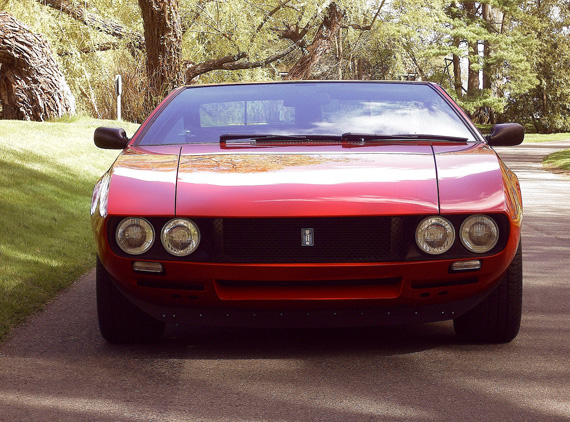
From the front the Mangusta is clearly a serious car. Standing solidly it presents a simple graphic statement that is devoid of embellishment. The De Tomaso emblem serves as a finely detailed aesthetic accent.
The body side theme has a very sharp and low accent line that visually brings the car closer to the ground, actually lower than what would be normally expected. The side window shapes show a passenger compartment volume far forward of the rear wheels and ahead of the engine. Three very thin air intakes behind the side windows also hint at performance and visually extend the side glass graphic. This takes visual weight out of the area above the engine.
In the rear of the car, the mid-engine architecture is very visible. The black air exhaust screens and the four bright metal tailpipes again visually reinforce the vehicle mission of high performance. The small screened vents below the twin rear windows imply something special that happens in the rear of the car and they allow additional engine air extraction and added rear vision for the driver.
Functionality
The Mangusta has a very tight interior package that requires the driver to fit its layout like a race car of the time. Size, weight, and performance have driven the basic design and engineering choices. The driver has a 75 millimeter wider space, providing more room for him to do his work than that of the passenger. Both sit at a slight angle to the centerline because of the large front wheel tubs. The large structural tunnel that runs through the center of the passenger compartment carries the shift linkage as well as the coolant tubes from the engine in the rear to the forward leaning radiator mounted in the front of the car.
There is a very small storage space behind the seats, but a very large luggage compartment directly behind the driver on the left side of the engine. The right side of the engine bay is occupied by the hand made and skillfully welded aluminum race style fuel tank. There is also a large felt-covered storage compartment under the aluminum front hood.
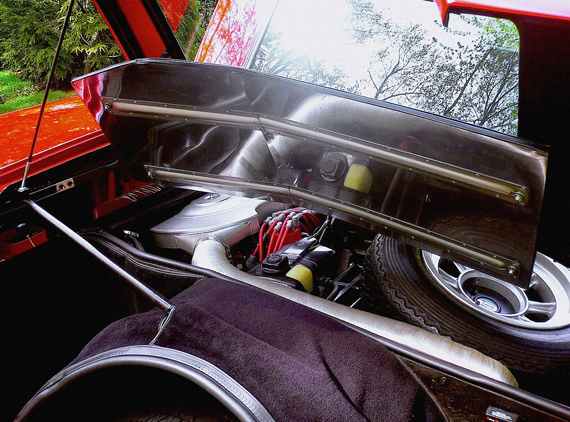
The engine located behind the passenger compartment is completely accessible by opening and then removing the rear panels that are attached to a central spine. It is attached with four 13mm bolts.
Engine accessibility is always a significant decision to be taken in the design of a mid-engine car. The twin engine hoods which open in gull wing fashion is a defining feature that is unique to the Mangusta. They are hinged on a central horizontal spine, and is a good solution because it makes the engine accessible for normal service. Both sides are completely removable with four 13 millimeter bolts. There is also a foldable, hinged panel directly behind the passenger compartment in front of the engine, and two easily removable panels above it. The main car body is a uni-body steel backbone structure with attached square tubular sub-frames that mount the suspension in the front and rear. The engine, transaxle, and rear suspension are mounted to the rear sub-frame that is attached to the rear firewall. This frame structure starts in the very front of the car and extends to the rear, including the structural tunnel to provide the attachment for the engine, transaxle, and rear suspension. The firewall in front of the engine contains a wide flat glass panel for rear vision. It also shields the driver and passenger from engine sound and fumes.
Removing the lightweight, leather-covered fiberglass console that fits over the boxed and welded tunnel between the seats reveals a thin pressed steel access panel in the firewall that is attached with 10 millimeter bolts. When removed it provides space to adjust accessory drive belts and the servicing of the engine water pump and hoses. Driving the car with this panel removed is an uncommon thrill as one rarely gets to ride in an engine compartment. Sitting inches away from the spinning belts and timing chain all of the engine, exhaust sounds, and vibrations along with the singing trans-axle synchronizers can be experienced firsthand.
Aerodynamics
The Mangusta shape clearly shows that Giorgetto Giugiaro was not only very skillful and experienced at designing automobiles, but that he also in his brief career had already accumulated a great deal of practical aerodynamic knowledge. There is no test data to refer to, no drag numbers or comparisons to be made, but my own extensive wind-tunnel experience tells me that the Mangusta is well conceived aerodynamically for the reasons that follow.
Going from front to rear the side profile curves downward past the passenger compartment to maintain surface air attachment until it breaks away at the crease across the Mangusta’s tail. In combination with the inward curving rear plan this creates a short and very small trailing wake helping to result in low aerodynamic drag. This vacuum trailing the car as it moves forward draws air through the mid-engine compartment and past the wire mesh between the tail-lamps helping to fill the void by exhausting hot air.
The front profile is shaped to create a high pressure bubble at the grill opening, resulting in a smooth and rounded air piercing shape and a high volume of air to the radiator and front and rear brakes.
In front view the Mangusta is noteworthy for its extreme tumble home. That is, the side windows lean inward at the top toward the centerline of the car, the frontal area is therefore very small. This area (A) times the co-efficient of drag, or (CD × A) would describe the force required to move the Mangusta through the air if it had ever been measured. Giugiaro used sound aerodynamic principles to shape the Mangusta at a time when aerodynamics was still part science and the rest a great deal of unknown and mystical black art.
The Mangusta Wheel Design
Normally the design of the wheels for a car are done at the end of the design program. They will be specifically designed to match the aesthetic character of the car. The 15-inch wheels of the Mangusta were not designed for the car; they were after-market parts built by Campagnolo in seven-inch width for the front and eight-inch width for the rear with a four bolt pattern. The wheels were originally designed in Italy much earlier for rally racing in many sizes, widths, and offsets and those cast for the Mangusta were made early on in magnesium and then later in aluminum. Very wide wheels were on the original P70 chassis when shown in Turin.
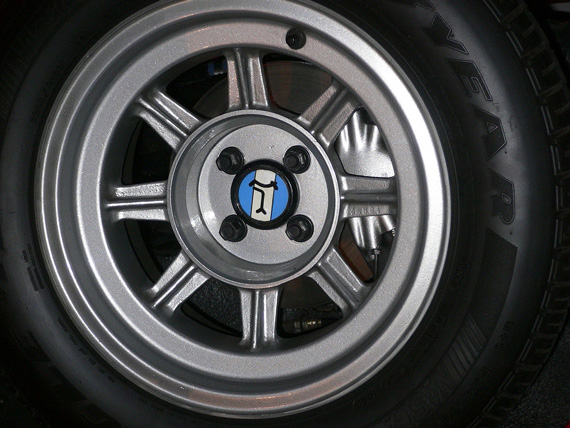
The Mangusta’s cast magnesium wheels are “ROUTE SPECIALI DA COMPETIZONE”, manufactured by CAMPAGNOLO of Italy. They are 15 inches in diameter, 7 inches wide in the front and 8 inches wide in the rear. Some Mangustas have the same wheel design and sizes but the wheels were cast in aluminum alloy
The design of the chosen wheel fits the Mangusta aesthetic very well and they are a very important part of the overall design success. In fact, the wheel design with its racing heritage could not be a better match for the Mangusta’s racing chassis. The reinforced structural look of the individual spokes and exposed lug nuts are consistent with the Mangusta theme. They add just the right amount of mechanical complexity to the Mangusta’s overall visual presentation. The center mounted De Tomaso emblem adds a colored accent to the wheel and although the wheel was made for ultimate performance as a racing component, it could not be done without at least the minimum application of Italian artistic content. The wheel design adds great value to the Mangusta aesthetic.
The Mangusta in Total
The Mangusta is an extreme, race inspired vehicle design that has well thought out spatial organization. Compromises to enhance the design solution have been well utilized to result in a dramatic design that has lived very well through the decades. It has a design and form language that has been emulated by many others but never done quite as well due to Giorgetto Guigiaro’s masterful skills and his ability to execute his designs. The Mangusta’s Italian-inspired aesthetic design is significant because it influenced car designers around the world as its appearance sharply broke with the design trend of the time. This break can be seen in Giugiaro’s own work that was done immediately before the Mangusta. There are many examples of cars both in Europe and the United States designed after it appeared that clearly show its aesthetic influence and inspiration.
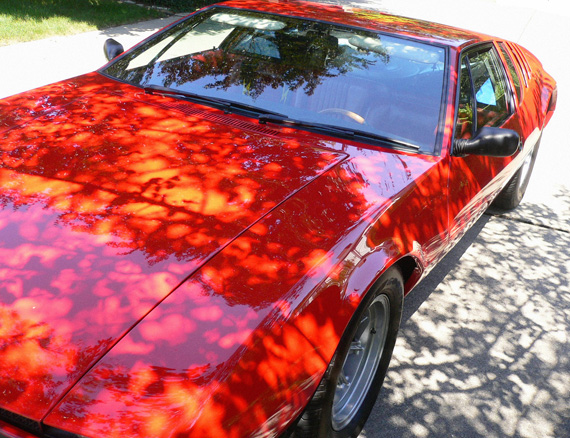
I could not resist taking this very unusual picture of my Mangusta as it sat under a small tree at the end of my driveway on a sunny spring day. Simplicity of shape like no other car.
Much time has gone by since those days when the Mangusta was created. You will have to be the judge as to whether Alessandro De Tomaso’s race car dream “for the highways and downtown” was successful as we see it today, so many years later. The Mangusta is a very rare car that evokes an immediate response of curiosity, excitement and great admiration even when in the company of other very rare and special cars. It does realize De Tomaso’s dream by creating a dialogue “between people keen on automobiles”.
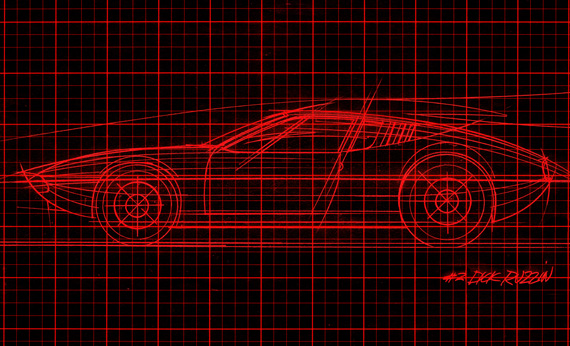
Hi Dick:
Great pictures and analysis. Few misc. questions:
–I realize aero was in its infancy back then but hasn’t subsequent owners proved it needs a chin spoiler. Up to what speed could you drive safetly without one?
-what are the round holes for in the front undertray? Were those for some feature never added (like brake air hoses?)
-the original prototype had blacked out trim. Was that the inspiration for blacked out chrome that swept the industry? Do you feel chrome looks better on the Mangusta than the black out chrome?
-the gold prototype is now a running car whereas in its original auto show display it was a mockup (with painted on gauges). Now it is a running car. To your knowledge was an already serial-numbered Mangusta chassis sacrificed to make the prototype a running car?
-later on in your series of articles on the car or in your book do you discuss the need for a protector plate for the gearbox? I have seen one where the plate is designed to skid smoothly over some road bump you did not see, but wonder if even that is adequate.
–I realize aero was in its infancy back then but hasn’t subsequent owners proved it needs a chin spoiler. Up to what speed could you drive safetly without one?
DR-Any car of that era can use a spoiler at the bottom of the radiator that extends one inch below the underbody. It will cause a vacuum behind the radiator to facilitate cooling and prevent hot radiator air from recirculating to the front of the car when stopped. It will also help reduce lift.
Aero effects cars at all speeds but most aero is set at 55 to 60 mph and will not change after that. If the attitude of the Mangusta is set right with the rocker flange horizontal and parallel to the ground there should not be any lift.
-what are the round holes for in the front undertray? Were those for some feature never added (like brake air hoses?)
DR-The outboard openings are divided into two parts with one side having a welded in tube, probably for the brakes. Another sign that racing was on de Tomaso’s mind. There are also two 2 inch diameter tubes that run from the front to the back exiting in front of the engine, reason unknown.
The center round holes in front of the radiator were probably there to reduce front end lift. I found that closing them off helped low speed cooling and high speed lift as the small spoiler became more effective. Large forward spoilers above the underbody are not effective, they are mostly for looks.
-the original prototype had blacked out trim. Was that the inspiration for blacked out chrome that swept the industry? Do you feel chrome looks better on the Mangusta than the black out chrome?
DR-Black chrome was coming but what Guigiaro was doing was simplifying the theme, the simpler it is the more memorable it is. Race cars do not have chrome trim. It was added later obviously for sales reasons.
-the gold prototype is now a running car whereas in its original auto show display it was a mockup (with painted on gauges). Now it is a running car. To your knowledge was an already serial-numbered Mangusta chassis sacrificed to make the prototype a running car?
DR-I have no idea.
-later on in your series of articles on the car or in your book do you discuss the need for a protector plate for the gearbox? I have seen one where the plate is designed to skid smoothly over some road bump you did not see, but wonder if even that is adequate.
DR-My book is about the design of the Mangusta, the forces behind that and de Tomaso’s desire for a race car for the street and highway.
The gearbox is not vulnerable, the bottom of the bell housing containing the flywheel and clutch is the closest part of the car to the ground. With the car set up properly there is 41/2 inches of road clearance.
DICK RUZZIN